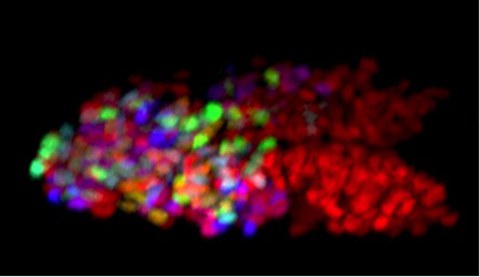Sep 22, 2017
New study on proliferative and functional heterogeneity of beta-cells in zebrafish published

The image shows the zebrafish β-cells labeled using the Beta-bow system through the combinatorial expression of fluorescent proteins, allowing the developmental history of beta cells to be traced during islet growth.
Scientists from Nikolay Ninov’s group at the DFG-Center for Regenerative Therapies Dresden (CRTD) and the IPI/PLID, in collaboration with researchers from the CRTD, Japan and the UK published their work on tracing the developmental histories of pancreatic beta-cells in Nature Communications.
Sumeet Pal Singh and colleagues found that the pancreatic islet is composed of heterogeneous populations of beta-cells, which show different capacities to proliferate and to perform functional roles. A population of “young” beta-cells, differentiating from tissue-resident stem cells, are primed for proliferation and help to increase the number of beta-cells within the islet. In contrast, a population of “older“ beta-cells are less capable to proliferate but excellent in performing the islet’s functional tasks upon glucose stimulation.
To be able to trace the histories of beta-cells, the team developed the so-called Beta-bow system, which allows to genetically bar-code beta-cells using multicolor imaging and to follow their evolution over time. In addition, the scientists monitored the function of beta-cells using a new transgenic reporter in which beta-cells shine “green light” as soon as they respond to glucose. As the factors that contribute to the diversity among human beta-cells remain unclear, the possibility to directly visualize the evolution of the beta-cell heterogeneity within an islet in zebrafish will help to understand the dynamic regulation of beta-cell states. This knowledge is of crucial importance for the subsequent development of effective strategies for beta-cell regeneration and protection in diabetes.
Further information can be found here.
